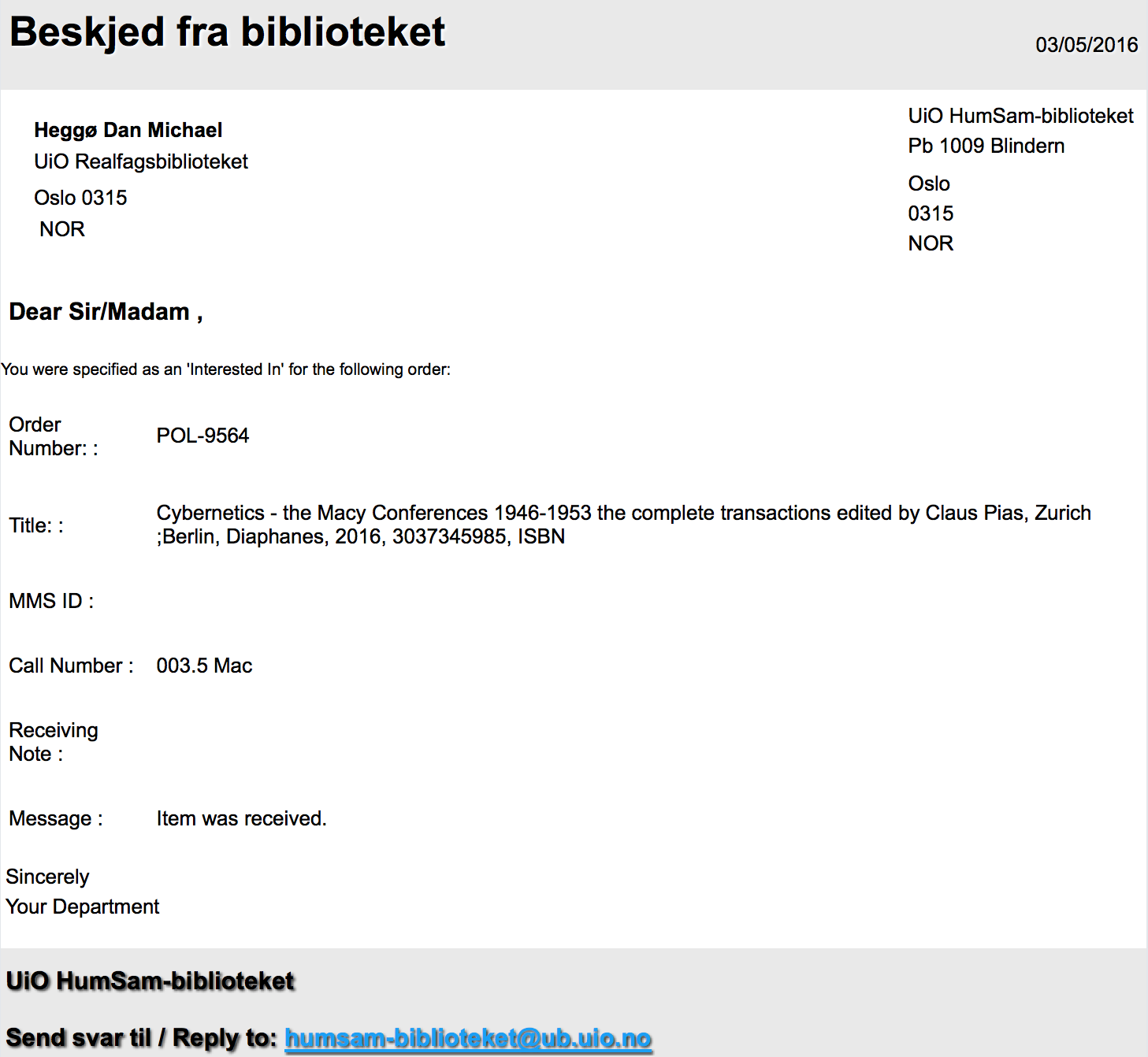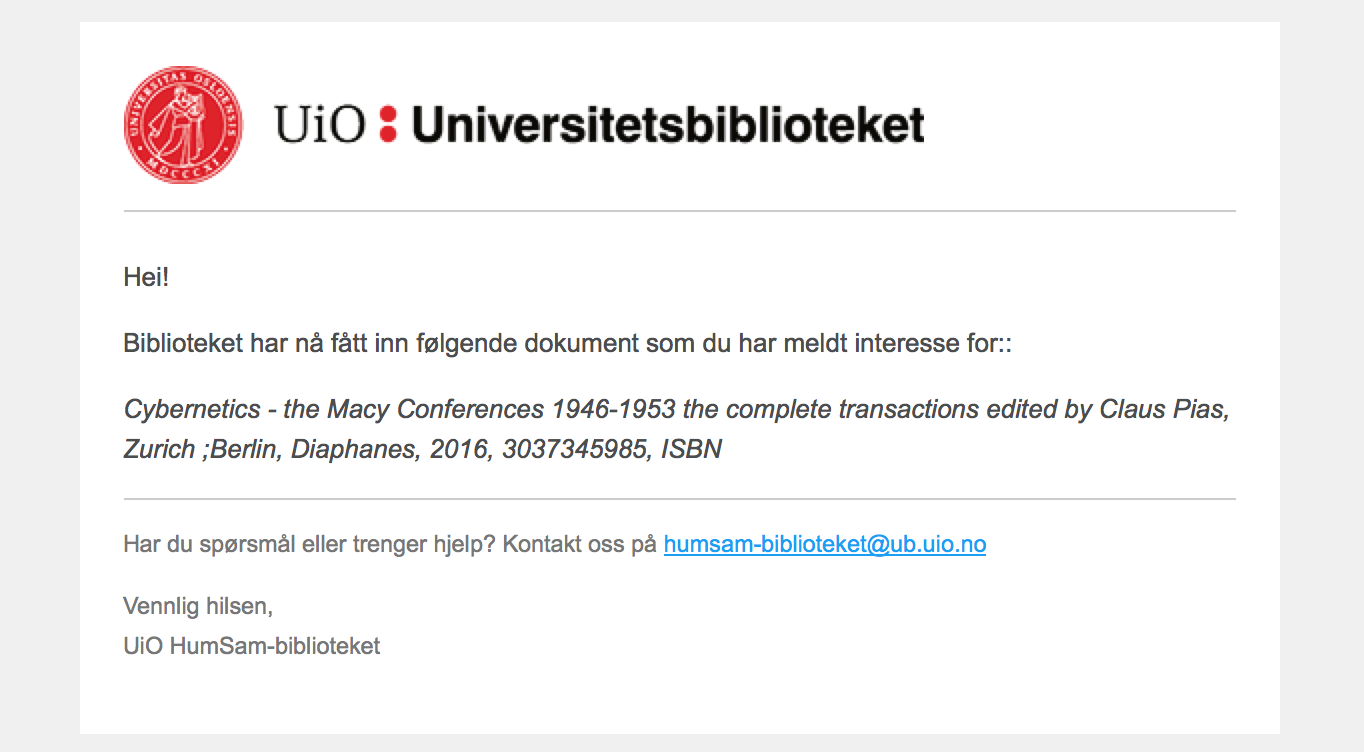Alma letters & slips under version control
We’ve published our Alma letters & slips and a script for synchronizing them with Alma at GitHub. This post provides some background on how we’re working with the files at the University of Oslo Library.
What letters?
Alma comes with a growing number of XSLT templates (currently 87) called “letters”, that cover basically everything to be printed or sent by email or sms from the system, including all communication with users and all slips that follow documents during processes such as inter-library loans.
Each time a letter is needed, Alma produces an XML file with the necessary data, which it then couples it with the corresponding XSLT template using some XSLT processor to produce HTML that is sent by email either directly to an end user or to an email address connected in some way to a printer.
HTML certainly isn’t the best format for print, but it’s possible to get good results with some effort. We’re currently converting the HTML to PostScript using html2ps, which is dead easy to install and support, but it’s a bit limiting that it doesn’t support CSS.
Starting from the default templates
When did you last see an email written like a formal letter, starting with the full postal address of the sender and recipient?
Here’s an example of a letter produced using one of the default templates to inform a user that a document he or she has shown interest for is now available:

Great, huh? Apart from the overly formal (and weird) style and the awful layout, note that there’s also no call-to-action button to, say, reserve the item in Primo or even look it up the there! It’s like this letter is really supposed to be printed and sent by post, not emailed.
When it came to the slips, they often lacked essential information. Requests for a specific journal article would in some cases only show the name of the journal, not any information about the article, sending slips did not include the library number for the recipient, self-service pick up slips did not include pick-up numbers, etc.
Adding version control
Realizing that we would have to do quite a lot of modifications to the defaults, we started thinking about how we could keep track of the changes and also be able to merge in upstream changes from Ex Libris. We needed version control!
So earlier this year we set up a Git repo for the letters. To be able to track upstream changes from Ex Libris, we also included in it a folder for all the default letters.
Syncing local templates with Alma using Selenium
Having a Git repo is fine, but Alma doesn’t provide Git or GitHub integration. Worse though, it doesn’t even provide a file transfer protocol for the letters – there’s no (s)ftp, webdav, rest-api, what have you.
While we’re waiting for this, the only way to edit the XSLT templates seems to be through the form within the Alma interface. Which by the way doesn’t provide an embedded code editor like Ace, so to remain sane, you need to copy the content into your favourite text editor, do the editing, before you copy it back.
After doing this for a while, you end up writing a script which does the copying back and forth for you. So we wrote slipsomat, which is a command line script to pull in changes from Alma and push local changes back. Since there’s no file transfer protocol we can use, we use Selenium browser automation, which is kinda crazy and prone to break on updates, it works fine most of the time.
Then, in order to avoid overwriting the work of others, the script also stores checksums for all the letters in a status file. If someone changes a letter directly in Alma, its checksum will no longer match the one in the status file, and the script will warn me when I try to push changes to that letter. If not, it will happily upload the letter or letters that have been modified and update the status file with new checksums:
Some more information on our workflow is available in the readme.
And in case you wonder how the example letter above looks with our latest templates, here it is:

As you see, we still haven’t found a way to introduce a call-for-action button. Also, there are some odd data quality issues in this example that cannot be fixed by a template, like why is the isbn part of the title field..? Oh well, just another day with Alma.